TPMS HYUNDAI TUCSON 2014 Owners Manual
[x] Cancel search | Manufacturer: HYUNDAI, Model Year: 2014, Model line: TUCSON, Model: HYUNDAI TUCSON 2014Pages: 542, PDF Size: 7.59 MB
Page 123 of 542
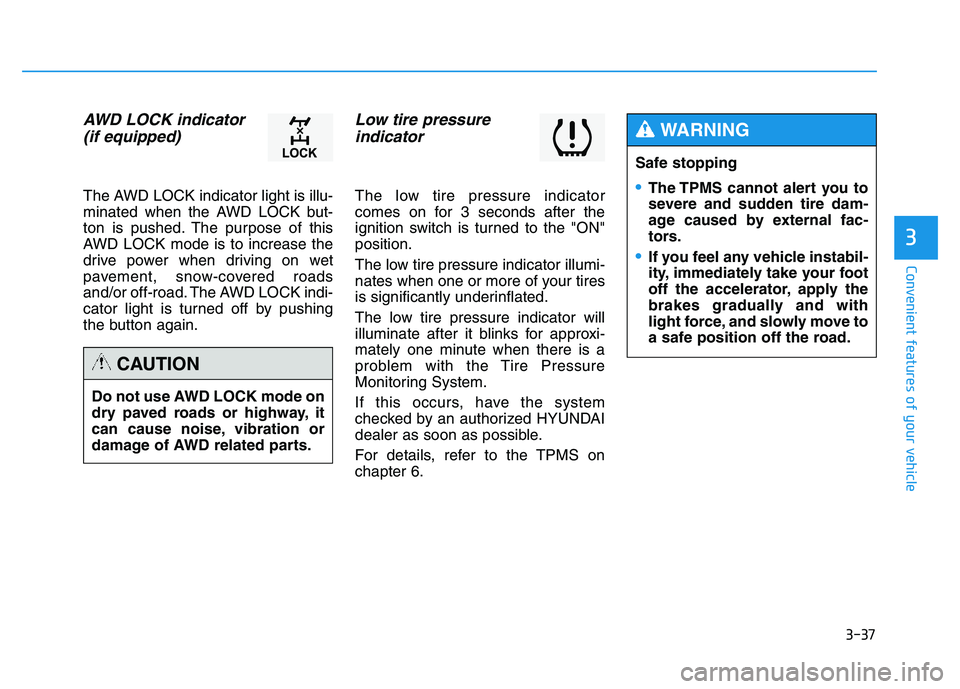
3-37
Convenient features of your vehicle
3
AWD LOCK indicator (if equipped)
The AWD LOCK indicator light is illu-
minated when the AWD LOCK but-
ton is pushed. The purpose of this
AWD LOCK mode is to increase the
drive power when driving on wet
pavement, snow-covered roads
and/or off-road. The AWD LOCK indi-
cator light is turned off by pushing
the button again.
Low tire pressure indicator
The low tire pressure indicator
comes on for 3 seconds after the
ignition switch is turned to the "ON"position.
The low tire pressure indicator illumi-
nates when one or more of your tires
is significantly underinflated.
The low tire pressure indicator will
illuminate after it blinks for approxi-
mately one minute when there is a
problem with the Tire Pressure
Monitoring System.
If this occurs, have the system
checked by an authorized HYUNDAI
dealer as soon as possible.
For details, refer to the TPMS on chapter 6.
Do not use AWD LOCK mode on
dry paved roads or highway, it
can cause noise, vibration or
damage of AWD related parts.
CAUTION
Safe stopping
The TPMS cannot alert you to
severe and sudden tire dam-
age caused by external fac-
tors.
If you feel any vehicle instabil-
ity, immediately take your foot
off the accelerator, apply the
brakes gradually and with
light force, and slowly move to
a safe position off the road.
WARNING
Page 407 of 542
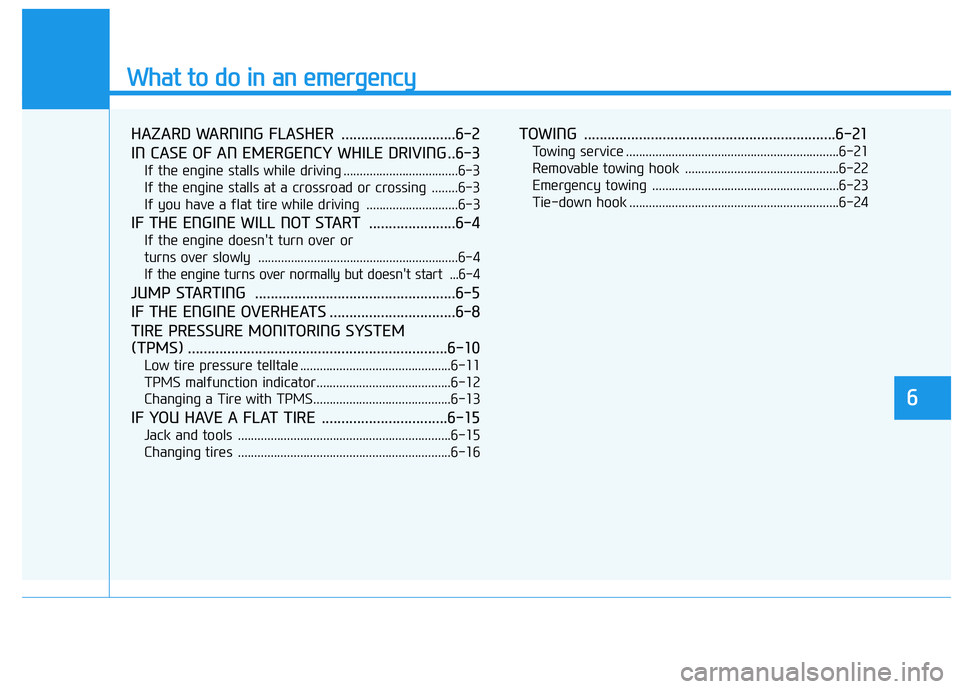
What to do in an emergency
HAZARD WARNING FLASHER .............................6-2
IN CASE OF AN EMERGENCY WHILE DRIVING ..6-3
If the engine stalls while driving ...................................6-3
If the engine stalls at a crossroad or crossing ........6-3
If you have a flat tire while driving ............................6-3
IF THE ENGINE WILL NOT START ......................6-4
If the engine doesn't turn over or
turns over slowly .............................................................6-4
If the engine turns over normally but doesn't start ...6-4
JUMP STARTING ...................................................6-5
IF THE ENGINE OVERHEATS ................................6-8
TIRE PRESSURE MONITORING SYSTEM
(TPMS) ..................................................................6-10
Low tire pressure telltale ..............................................6-11
TPMS malfunction indicator.........................................6-12
Changing a Tire with TPMS..........................................6-13
IF YOU HAVE A FLAT TIRE ................................6-15
Jack and tools .................................................................6-15
Changing tires .................................................................6-16
TOWING ................................................................6-21
Towing service .................................................................6-21
Removable towing hook ...............................................6-22
Emergency towing .........................................................6-23
Tie-down hook ................................................................6-24
6
Page 416 of 542
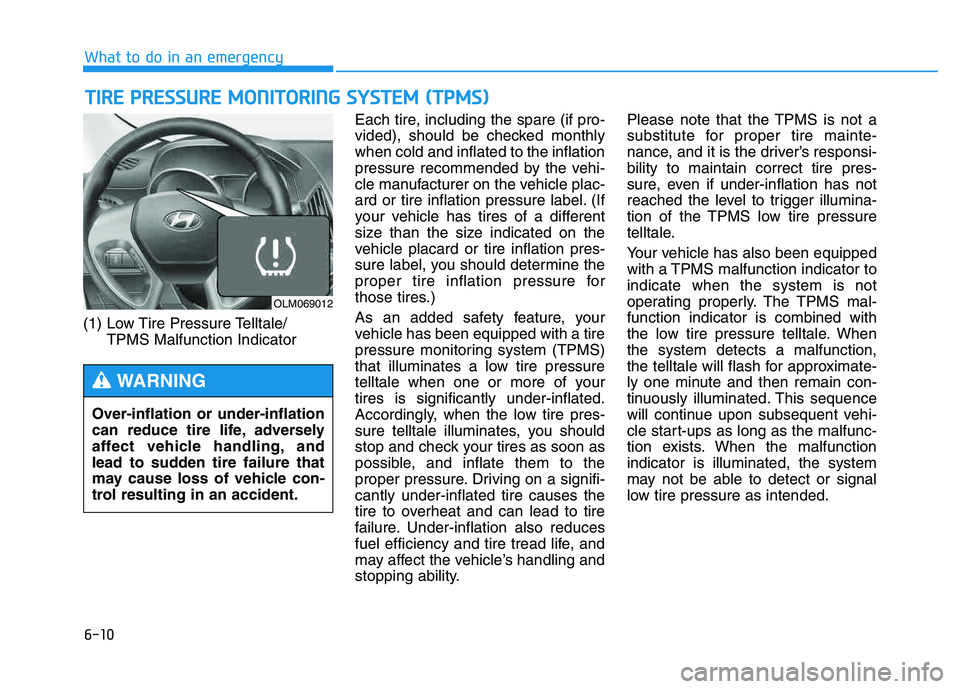
6-10
(1) Low Tire Pressure Telltale/TPMS Malfunction Indicator Each tire, including the spare (if pro-
vided), should be checked monthlywhen cold and inflated to the inflation
pressure recommended by the vehi-
cle manufacturer on the vehicle plac-
ard or tire inflation pressure label. (If
your vehicle has tires of a different
size than the size indicated on the
vehicle placard or tire inflation pres-
sure label, you should determine the
proper tire inflation pressure for
those tires.)
As an added safety feature, your
vehicle has been equipped with a tire
pressure monitoring system (TPMS)
that illuminates a low tire pressure
telltale when one or more of yourtires is significantly under-inflated.
Accordingly, when the low tire pres-
sure telltale illuminates, you should
stop and check your tires as soon as
possible, and inflate them to the
proper pressure. Driving on a signifi-cantly under-inflated tire causes the
tire to overheat and can lead to tire
failure. Under-inflation also reduces
fuel efficiency and tire tread life, and
may affect the vehicle’s handling and
stopping ability. Please note that the TPMS is not a
substitute for proper tire mainte-
nance, and it is the driver’s responsi-bility to maintain correct tire pres-
sure, even if under-inflation has not
reached the level to trigger illumina-
tion of the TPMS low tire pressure
telltale.
Your vehicle has also been equipped
with a TPMS malfunction indicator toindicate when the system is not
operating properly. The TPMS mal-function indicator is combined with
the low tire pressure telltale. Whenthe system detects a malfunction,
the telltale will flash for approximate-
ly one minute and then remain con-
tinuously illuminated. This sequence
will continue upon subsequent vehi-
cle start-ups as long as the malfunc-
tion exists. When the malfunctionindicator is illuminated, the system
may not be able to detect or signal
low tire pressure as intended.
TT
IIRR EE PP RR EESSSSUU RREE MM OONNIITT OO RRIINN GG SS YY SSTT EEMM (( TT PP MM SS))
What to do in an emergency
OLM069012
Over-inflation or under-inflation
can reduce tire life, adversely
affect vehicle handling, and
lead to sudden tire failure that
may cause loss of vehicle con-
trol resulting in an accident.
WARNING
Page 417 of 542
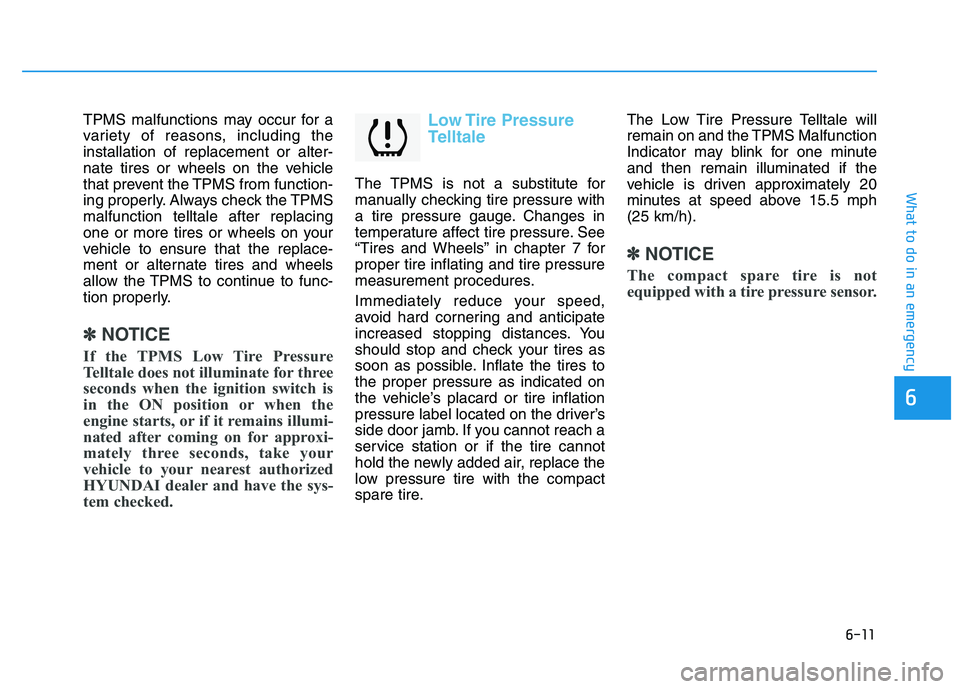
6-11
What to do in an emergency
TPMS malfunctions may occur for a
variety of reasons, including theinstallation of replacement or alter-
nate tires or wheels on the vehicle
that prevent the TPMS from function-
ing properly. Always check the TPMSmalfunction telltale after replacing
one or more tires or wheels on your
vehicle to ensure that the replace-
ment or alternate tires and wheels
allow the TPMS to continue to func-
tion properly.
✽✽NOTICE
If the TPMS Low Tire Pressure
Telltale does not illuminate for three
seconds when the ignition switch is
in the ON position or when the
engine starts, or if it remains illumi-
nated after coming on for approxi-
mately three seconds, take your
vehicle to your nearest authorized
HYUNDAI dealer and have the sys-
tem checked.
Low Tire Pressure
Telltale
The TPMS is not a substitute for
manually checking tire pressure with
a tire pressure gauge. Changes in
temperature affect tire pressure. See
“Tires and Wheels” in chapter 7 forproper tire inflating and tire pressure
measurement procedures.
Immediately reduce your speed,
avoid hard cornering and anticipate
increased stopping distances. You
should stop and check your tires as
soon as possible. Inflate the tires tothe proper pressure as indicated on
the vehicle’s placard or tire inflation
pressure label located on the driver’s
side door jamb. If you cannot reach a
service station or if the tire cannot
hold the newly added air, replace the
low pressure tire with the compact
spare tire. The Low Tire Pressure Telltale will
remain on and the TPMS Malfunction
Indicator may blink for one minuteand then remain illuminated if the
vehicle is driven approximately 20
minutes at speed above 15.5 mph(25 km/h).
✽✽
NOTICE
The compact spare tire is not
equipped with a tire pressure sensor.
6
Page 418 of 542
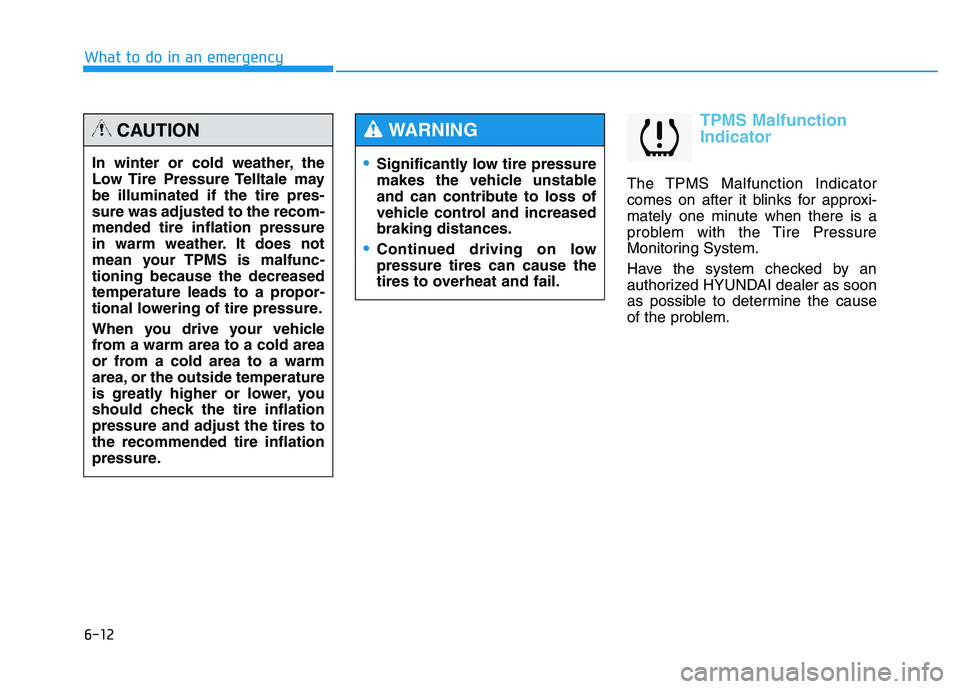
6-12
TPMS Malfunction Indicator
The TPMS Malfunction Indicator
comes on after it blinks for approxi-
mately one minute when there is a
problem with the Tire Pressure
Monitoring System.
Have the system checked by an
authorized HYUNDAI dealer as soon
as possible to determine the cause
of the problem.
What to do in an emergency
In winter or cold weather, the
Low Tire Pressure Telltale maybe illuminated if the tire pres-sure was adjusted to the recom-mended tire inflation pressure
in warm weather. It does not
mean your TPMS is malfunc-tioning because the decreased
temperature leads to a propor-
tional lowering of tire pressure.
When you drive your vehicle
from a warm area to a cold area
or from a cold area to a warm
area, or the outside temperature
is greatly higher or lower, you
should check the tire inflationpressure and adjust the tires tothe recommended tire inflation
pressure.
CAUTION
Significantly low tire pressure
makes the vehicle unstable
and can contribute to loss of
vehicle control and increasedbraking distances.
Continued driving on low pressure tires can cause the
tires to overheat and fail.
WARNING
Page 419 of 542
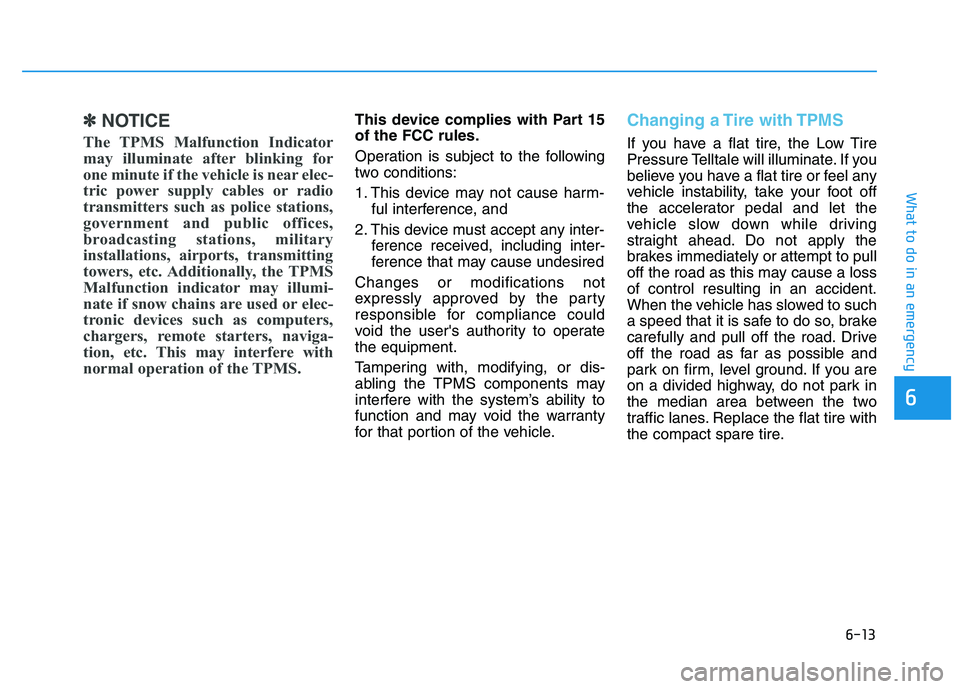
6-13
What to do in an emergency
✽✽NOTICE
The TPMS Malfunction Indicator
may illuminate after blinking for
one minute if the vehicle is near elec-
tric power supply cables or radio
transmitters such as police stations,
government and public offices,
broadcasting stations, military
installations, airports, transmitting
towers, etc. Additionally, the TPMS
Malfunction indicator may illumi-
nate if snow chains are used or elec-
tronic devices such as computers,
chargers, remote starters, naviga-
tion, etc. This may interfere with
normal operation of the TPMS.This device complies with Part 15 of the FCC rules.
Operation is subject to the following
two conditions:
1. This device may not cause harm- ful interference, and
2. This device must accept any inter- ference received, including inter-
ference that may cause undesired
Changes or modifications not
expressly approved by the party
responsible for compliance could
void the user's authority to operatethe equipment.
Tampering with, modifying, or dis-
abling the TPMS components may
interfere with the system’s ability to
function and may void the warranty
for that portion of the vehicle.Changing a Tire with TPMS
If you have a flat tire, the Low Tire
Pressure Telltale will illuminate. If you
believe you have a flat tire or feel any
vehicle instability, take your foot off
the accelerator pedal and let the
vehicle slow down while driving
straight ahead. Do not apply the
brakes immediately or attempt to pull
off the road as this may cause a lossof control resulting in an accident.
When the vehicle has slowed to such
a speed that it is safe to do so, brake
carefully and pull off the road. Drive
off the road as far as possible and
park on firm, level ground. If you are
on a divided highway, do not park in
the median area between the two
traffic lanes. Replace the flat tire with
the compact spare tire.
6
Page 420 of 542
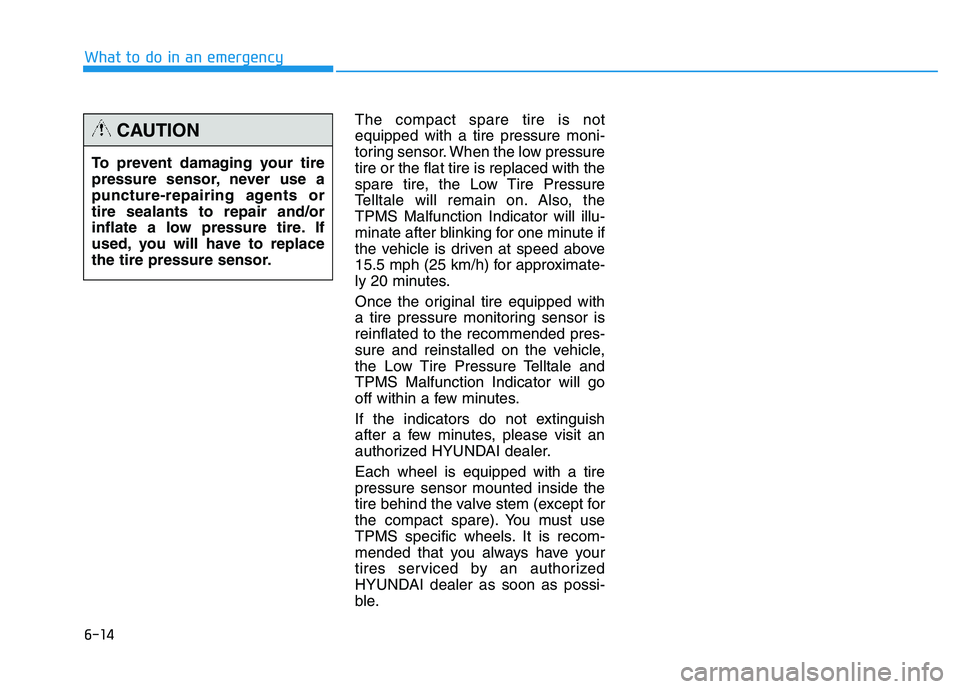
6-14
The compact spare tire is not equipped with a tire pressure moni-
toring sensor. When the low pressuretire or the flat tire is replaced with the
spare tire, the Low Tire Pressure
Telltale will remain on. Also, theTPMS Malfunction Indicator will illu-
minate after blinking for one minute if
the vehicle is driven at speed above
15.5 mph (25 km/h) for approximate-
ly 20 minutes.
Once the original tire equipped with
a tire pressure monitoring sensor isreinflated to the recommended pres-
sure and reinstalled on the vehicle,
the Low Tire Pressure Telltale andTPMS Malfunction Indicator will go
off within a few minutes.
If the indicators do not extinguish
after a few minutes, please visit an
authorized HYUNDAI dealer. Each wheel is equipped with a tire pressure sensor mounted inside the
tire behind the valve stem (except for
the compact spare). You must use
TPMS specific wheels. It is recom-
mended that you always have your
tires serviced by an authorized
HYUNDAI dealer as soon as possi-
ble.
What to do in an emergency
To prevent damaging your tire
pressure sensor, never use a
puncture-repairing agents ortire sealants to repair and/or
inflate a low pressure tire. If
used, you will have to replace
the tire pressure sensor.
CAUTION
Page 536 of 542
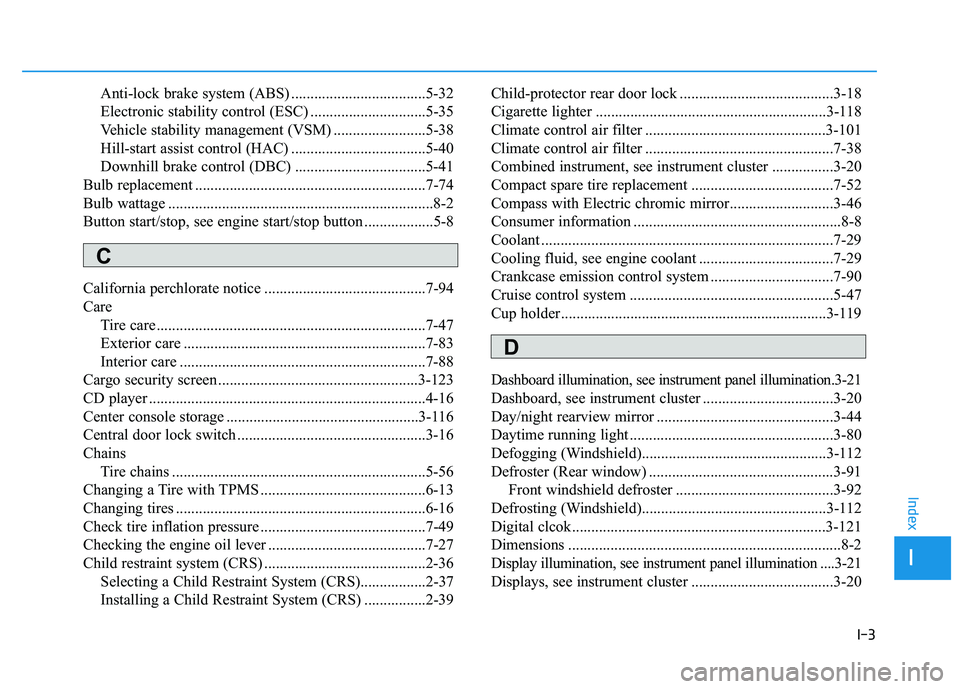
I-3
Anti-lock brake system (ABS) ...................................5-32
Electronic stability control (ESC) ..............................5-35
Vehicle stability management (VSM) ........................5-38
Hill-start assist control (HAC) ...................................5-40
Downhill brake control (DBC) ..................................5-41
Bulb replacement ............................................................7-74
Bulb wattage .....................................................................8-2
Button start/stop, see engine start/stop button ..................5-8
California perchlorate notice ..........................................7-94
Care Tire care ......................................................................7-47
Exterior care ...............................................................7-83
Interior care ................................................................7-88
Cargo security screen ....................................................3-123
CD player ........................................................................4-16
Center console storage ..................................................3-116
Central door lock switch .................................................3-16
Chains Tire chains ..................................................................5-56
Changing a Tire with TPMS ...........................................6-13
Changing tires .................................................................6-16
Check tire inflation pressure ...........................................7-49
Checking the engine oil lever .........................................7-27
Child restraint system (CRS) ..........................................2-36
Selecting a Child Restraint System (CRS).................2-37
Installing a Child Restraint System (CRS) ................2-39 Child-protector rear door lock ........................................3-18
Cigarette lighter ............................................................3-118
Climate control air filter ...............................................3-101
Climate control air filter .................................................7-38
Combined instrument, see instrument cluster ................3-20
Compact spare tire replacement .....................................7-52
Compass with Electric chromic mirror...........................3-46
Consumer information ......................................................8-8
Coolant ............................................................................7-29
Cooling fluid, see engine coolant ...................................7-29
Crankcase emission control system ................................7-90
Cruise control system .....................................................5-47
Cup holder .....................................................................3-119
Dashboard illumination, see instrument panel illumination.3-21
Dashboard, see instrument cluster ..................................3-20
Day/night rearview mirror ..............................................3-44
Daytime running light .....................................................3-80
Defogging (Windshield)................................................3-112
Defroster (Rear window) ................................................3-91
Front windshield defroster .........................................3-92
Defrosting (Windshield)................................................3-112
Digital clcok..................................................................3-121
Dimensions .......................................................................8-2
Display illumination, see instrument panel illumination ....3-21
Displays, see instrument cluster .....................................3-20
I
Index
C
D
Page 541 of 542
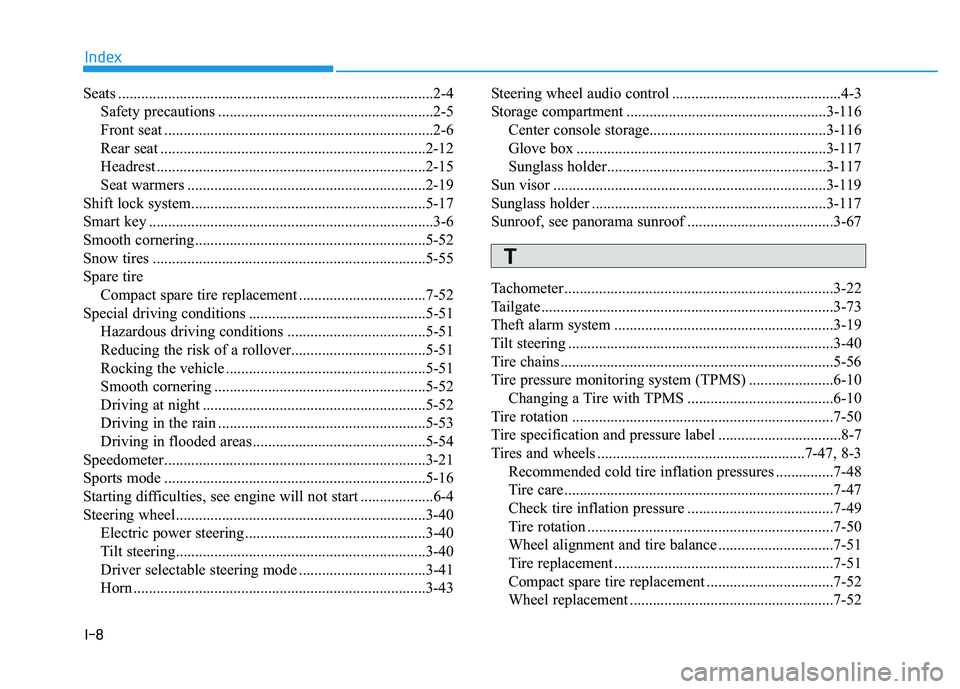
I-8
Seats ..................................................................................2-4Safety precautions ........................................................2-5
Front seat ......................................................................2-6
Rear seat .....................................................................2-12
Headrest ......................................................................2-15
Seat warmers ..............................................................2-19
Shift lock system.............................................................5-17
Smart key ..........................................................................3-6
Smooth cornering............................................................5-52
Snow tires .......................................................................5-55
Spare tire Compact spare tire replacement .................................7-52
Special driving conditions ..............................................5-51 Hazardous driving conditions ....................................5-51
Reducing the risk of a rollover...................................5-51
Rocking the vehicle ....................................................5-51
Smooth cornering .......................................................5-52
Driving at night ..........................................................5-52
Driving in the rain ......................................................5-53
Driving in flooded areas .............................................5-54
Speedometer....................................................................3-21
Sports mode ....................................................................5-16
Starting difficulties, see engine will not start ...................6-4
Steering wheel.................................................................3-40 Electric power steering ...............................................3-40
Tilt steering.................................................................3-40
Driver selectable steering mode .................................3-41
Horn ............................................................................3-43 Steering wheel audio control ............................................4-3
Storage compartment ....................................................3-116
Center console storage..............................................3-116
Glove box .................................................................3-117
Sunglass holder.........................................................3-117
Sun visor .......................................................................3-119
Sunglass holder .............................................................3-117
Sunroof, see panorama sunroof ......................................3-67
Tachometer ......................................................................3-22
Tailgate ............................................................................3-73
Theft alarm system .........................................................3-19
Tilt steering .....................................................................3-40
Tire chains .......................................................................5-56
Tire pressure monitoring system (TPMS) ......................6-10 Changing a Tire with TPMS ......................................6-10
Tire rotation ....................................................................7-50
Tire specification and pressure label ................................8-7
Tires and wheels ......................................................7-47, 8-3
Recommended cold tire inflation pressures ...............7-48
Tire care ......................................................................7-47
Check tire inflation pressure ......................................7-49
Tire rotation ................................................................7-50
Wheel alignment and tire balance ..............................7-51
Tire replacement .........................................................7-51
Compact spare tire replacement .................................7-52
Wheel replacement .....................................................7-52
Index
T